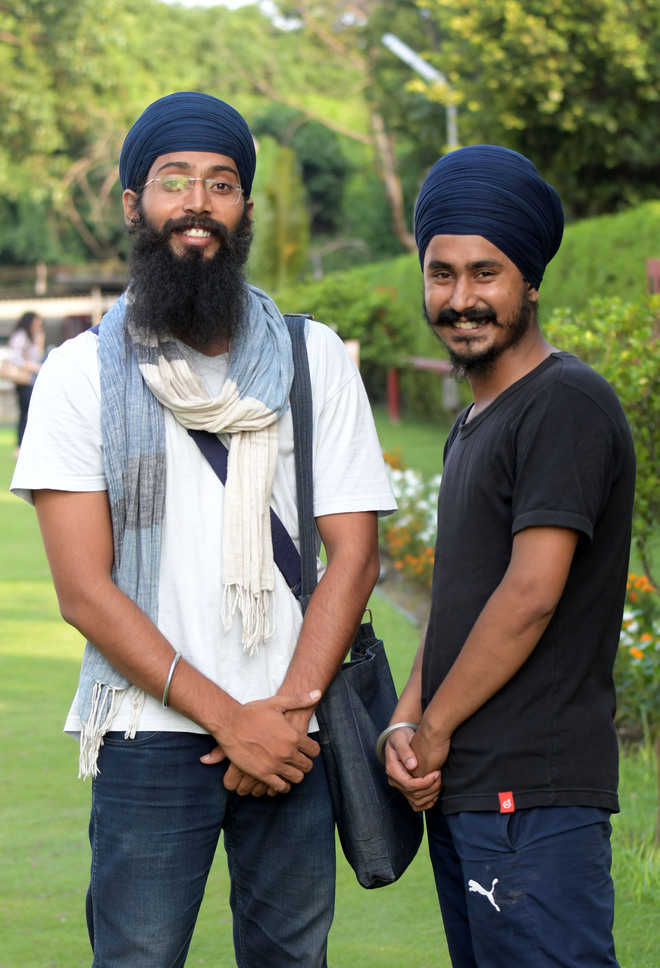Amarjot Kaur
The task of salvaging ancient calligraphy and inks, especially those that date back to 1604, could mean studying old religious testaments for over two years. It could also mean having to stay at deras in Punjab and Haryana, or travelling to Rajasthan’s Kagzi Colony to trace the lineage of the man who made paper for the fifth Sikh guru, Guru Arjan Dev, for the Adi Granth to be written on by Bhai Gurdas ji.
This idea may make you break into cold sweat, but 23-year-old Mahtab Singh and his two-year senior Amanjot Singh went at it with hammer and tongs. The duo recreated the Roshanai ink, with which the first Adi Granth was written and are reviving the calligraphy it was written in. Besides, they have also discovered 15 herbal inks used in ancient scriptures.
Joining hands
Mahtab from Muktsar is a student at Panjab University, currently pursuing masters in Punjabi. Amanjot, who hails from Jalandhar, passed-out from PU’s Department of English Literature this year. “It was in 2015 that Mahtab started researching on inks used in Adi Granth,” informs Amanjot. Mahtab is prompt to add, “It was like connecting the links, from one dot to another. I first studied the scriptures at different deras, starting from Mahant Kashmir Das Da Dera in Muktsar to Kahn Singh Da Dera in Bathinda and Tikana Bhai Moola Sahib in Rohtak. We finally found a copy of Adi Granth, at Moola Sahib’s dera.”
There, Mahtab found about the man who made the ink used in Adi Granth. “I stood informed that Bhai Banno made the Roshanai ink and its vidhi (technique) was undersigned by him in the Granth. But Punjabi language has evolved ever since and it was difficult to understand the names of the ingredients mentioned in the vidhi.We referred to a professor in Guru Nanak Dev University of Amritsar, Amar Singh, and well-known artist Sidharth, who has worked extensively on herbal colours, to know more about inks. Roshanai, according to Bhai Banno’s vidhi, is made with gold, kajjal, bol (kikkar gond), lagwarda, Bijaysar da paani, dhur da kajjal, and neem, and prepared in a copper vessel,” he says.
The duo explains that it was through hit and trial, and repetitive experimentation that they were able to recreate the Roshanai ink. “Of course, it took us two years of research to get the ink right . Even now if you look at the Saroop, you’ll find the ink hasn’t lost its sheen. Perhaps, it is because with time most ingredients evaporate leaving the gold and kalak behind. Also, Roshanai is waterproof and lasts for more than 500 years,” Amanjot chips in.
True dedication
Since then, Mahtab and Amanjot have been creating herbal inks and reviving the ancient Punjabi (Gurmukhi) calligraphy. They have been taking calligraphy workshops at city’s social enterprise Chotti Si Asha and Khalsa College, GNE College in Ludhiana, and at summer camps in Hoshiarpur. “We have recreated 15 different inks made from walnuts, honey, kajal, marigold flower, pomegranate, beetroot, kikkar, sikka, tea leaves, kattha, and vijaysaar,” says Mahtab, who has also exhibited his calligraphy texts at gurdwaras in Muktsar and in GNE College.
Their Facebook page QalmDwaat@QalamDawaatenterprises has 947 likes. Mahtab is currently writing the Guru Granth Sahib in ancient calligraphy using Roshanai on pateel (the paper used to write Adi Granth in 1604). “I wanted to write the Guru Granth Sahib the way it was written in 1604. I went to the Kagzi Colony in Rajasthan and met a family that claimed to be the 22nd generation of papermakers. They told me their ancestors made paper (pateel) used in the Adi Granth. I am also making calligraphy pens with bamboo. This is the subject I want to study for my PhD,” he says. Mahtab intends to sell these inks. “Herbal inks are mostly imported from China and are very expensive. We intend on making these inks available to masses for cheap, but that’s just an idea we have on the list,” he smiles and signs off.
amarjot@tribunemail.com
Unlock Exclusive Insights with The Tribune Premium
Take your experience further with Premium access.
Thought-provoking Opinions, Expert Analysis, In-depth Insights and other Member Only Benefits
Already a Member? Sign In Now










